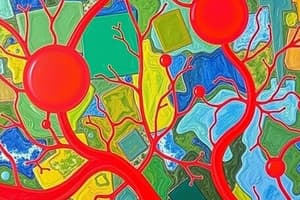Podcast
Questions and Answers
What is the primary function of albumins in plasma?
What is the primary function of albumins in plasma?
- Create osmotic pressure in blood (correct)
- Enable red blood cell flexibility
- Transport nutrients and electrolytes
- Facilitate white blood cell reproduction
Which type of white blood cell is primarily responsible for combating infections by ingesting bacteria?
Which type of white blood cell is primarily responsible for combating infections by ingesting bacteria?
- Neutrophils (correct)
- Eosinophils
- Lymphocytes
- Basophils
What is the primary component of blood plasma making up about 90% of its volume?
What is the primary component of blood plasma making up about 90% of its volume?
- Proteins
- Electrolytes
- Nutrients
- Water (correct)
What substance do red blood cells primarily produce that is essential for oxygen transport?
What substance do red blood cells primarily produce that is essential for oxygen transport?
Which cell type is involved in releasing histamine during allergic reactions?
Which cell type is involved in releasing histamine during allergic reactions?
What is the primary purpose of the circulatory system in multicellular organisms?
What is the primary purpose of the circulatory system in multicellular organisms?
Which circuit of the circulatory system is responsible for oxygenating blood?
Which circuit of the circulatory system is responsible for oxygenating blood?
What characteristic distinguishes a closed circulatory system from an open circulatory system?
What characteristic distinguishes a closed circulatory system from an open circulatory system?
How does an open circulatory system primarily benefit an organism?
How does an open circulatory system primarily benefit an organism?
What is the primary fluid in an open circulatory system that bathes the organs?
What is the primary fluid in an open circulatory system that bathes the organs?
Flashcards
Circulatory System
Circulatory System
A system that delivers oxygen, nutrients, and hormones to cells while removing waste products.
Closed Circulatory System
Closed Circulatory System
A closed network of vessels that transport blood throughout the body. Blood is pumped by a heart and travels in one direction.
Open Circulatory System
Open Circulatory System
A circulatory system where blood is not always contained within vessels and bathes organs directly. It requires less energy but has lower blood pressure.
Blood
Blood
Signup and view all the flashcards
Systemic Circulation
Systemic Circulation
Signup and view all the flashcards
What is plasma?
What is plasma?
Signup and view all the flashcards
What are the cellular components of blood?
What are the cellular components of blood?
Signup and view all the flashcards
What is hemoglobin?
What is hemoglobin?
Signup and view all the flashcards
What are macrophages?
What are macrophages?
Signup and view all the flashcards
What is centrifugation?
What is centrifugation?
Signup and view all the flashcards
Study Notes
Circulatory Systems
- Not all organisms have circulatory systems
- Unicellular and some simple multicellular organisms directly interact with their environment
- Example: Sponges
- Multicellular organisms need circulatory systems to transport nutrients and oxygen to cells and remove waste products
- Crucial for organisms whose cells are not in contact with the external environment.
- Two-circuit system
- Systemic circuit: Circulates blood to the head and body
- Pulmonary circuit: Circulates blood between the heart and lungs for oxygenation
- Oxygen-rich blood is bright red; oxygen-poor blood is deep red.
Key Functions of the Circulatory System
- Delivers oxygen from the respiratory system
- Delivers nutrients from the digestive system
- Delivers hormones from the endocrine system
- Delivers chemicals/cells from the immune system
- Removes metabolic wastes from cells (lungs and kidneys)
- Maintains body temperature (warm-blooded organisms)
Fundamental Features of Circulatory Systems
- Fluid that transports materials
- Network of tubes for fluid circulation
- Pump to push the fluid
Open Circulatory Systems
-
"Blood" is called hemolymph
-
Blood does not always stay in vessels
-
No true heart
-
Requires less energy due to low blood pressure
-
Examples: Insects, lobsters, crabs, oysters
-
Organs are bathed in this open blood for gas exchange & nutrient delivery
Closed Circulatory Systems
- Blood is contained within a network of vessels
- Faster flow (directionally)
- Suitable for larger organisms with higher metabolisms and waste removal needs
- Examples: Birds, mammals, fish, reptiles
Blood Composition
- Humans have 4-5 litres of blood
- Blood is a connective tissue of cells suspended in a matrix.
- Two components:
- Cellular components: Red blood cells, white blood cells, platelets
- Intercellular matrix: Plasma (a yellow liquid)
Plasma
- Protein-rich liquid
- Contains oxygen, carbon dioxide, proteins, nutrients (glucose, minerals, vitamins), and waste
- Mostly water (90%)
- Proteins: Albumins, globulins, fibrinogen
- Carries dissolved ions (Na+, K+, Ca2+, Cl-, HCO3−)
- Sodium ion concentration creates osmotic pressure gradient, influencing water movement in/out of blood
Red Blood Cells
- Produced in red bone marrow
- Contain hemoglobin (Hb)
- Heme (iron-containing pigment)
- Globin (protein)
- Flexible for capillary travel
- Normally circulate, except when broken down by the spleen(aged red blood cells)
- Engulfed by macrophages (in spleen, liver, marrow) when old
White Blood Cells
- Neutrophils: Combat infections by ingesting foreign particles (bacteria)
- Lymphocytes: Secrete antibodies to directly attack bacteria
- Monocytes: Largest WBC, ingest foreign bodies
- Eosinophils: Fight internal parasite infestations (worms), increase allergic responses (asthma, hay fever)
- Basophils: Release histamine in allergic reactions; release heparin for infection fighting (blood clotting prevention)
Studying That Suits You
Use AI to generate personalized quizzes and flashcards to suit your learning preferences.




